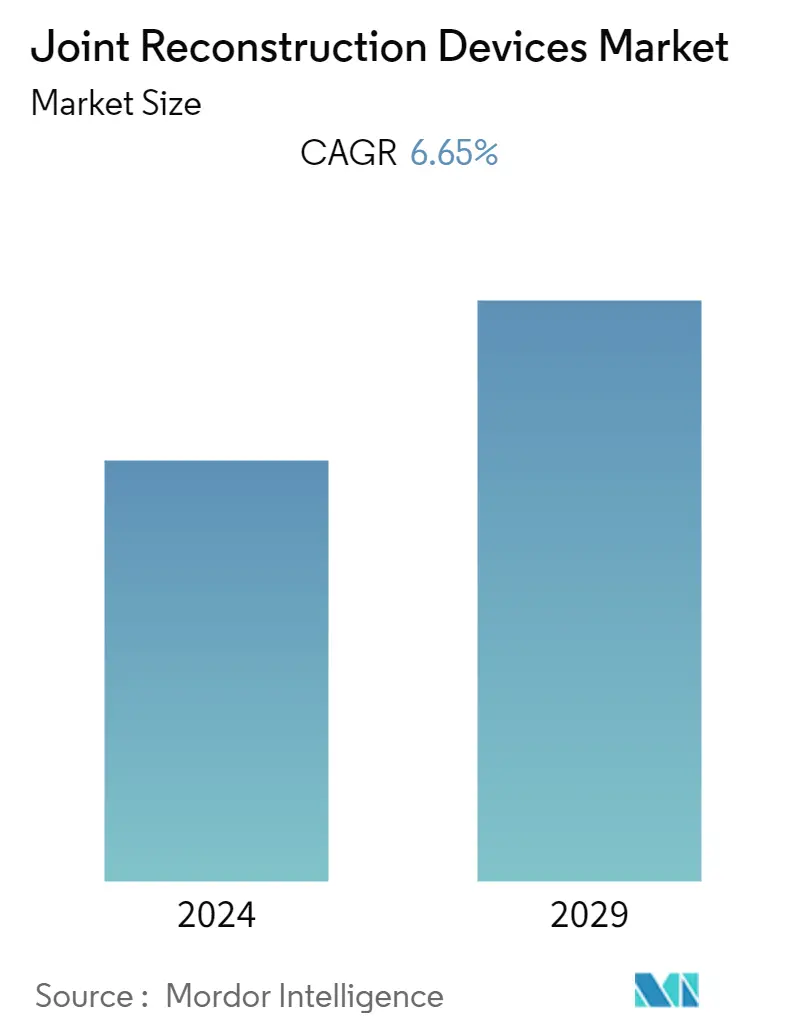Market Size of Joint Reconstruction Devices Industry

| Study Period | 2019 - 2029 |
| Base Year For Estimation | 2023 |
| Forecast Data Period | 2024 - 2029 |
| CAGR | 6.65 % |
| Fastest Growing Market | Asia Pacific |
| Largest Market | North America |
Major Players
*Disclaimer: Major Players sorted in no particular order |
Joint Reconstruction Devices Market Analysis
The joint reconstruction devices market is expected to witness a CAGR of 6.55% during the forecast period.
COVID-19 had impacted the joint reconstruction devices market due to the cancellation of elective surgeries. For instance, an article published in J. Arthroplasty in April 2021 reported that the COVID-19 pandemic significantly affected arthroplasty practice. The article also reported the cancellation of many hip and knee arthroplasty services during the pandemic, which directly impacted the joint reconstruction devices market. Thus, initially, the market faced significant challenges due to the pandemic restrictions. However, with the ease of government regulations and the resumption of healthcare services the market witnessed significant growth.
The key factors propelling the growth of the market studied are the growing prevalence of orthopedic diseases, the increasing aging population, the increasing preference for minimally invasive techniques, and an increasing number of large joint reconstruction surgeries. With the growing prevalence of orthopedic diseases such as arthritis, osteoporosis, knee injuries, etc., resulting in damage to bones and serious cases, joint reconstruction surgery is the ultimate treatment available. For instance, in December 2021, Work-Related Musculoskeletal Disorders Statistics in Great Britain reported that 4,70,000 workers suffered from work-related musculoskeletal disorders (new or long-standing) in 2020/21. This represents 1,420 per 100,000 workers and thus accounts for 28% of all work-induced ill health.
Similarly, another article published by the journal PTJ in January 2021 reported that musculoskeletal conditions are the most common causes of disability and limitations related to daily living and gainful employment in the United States. Thus, a high number of musculoskeletal conditions, including knee, hip, and other joint conditions, increase the demand for joint replacement surgical procedures. This is propelling the market's growth.
As the geriatric population increases, the market studied is also expected to grow as weak bones are more likely to develop in the geriatric population. Joint-related disorders are more likely to arise in the geriatric population, resulting in the need for joint reconstruction surgery, thereby driving the market for joint reconstruction devices. For instance, an article published in the journal, J. Am. Acad. Orthop. Surg. in January 2022 reported a higher prevalence of joint pain among the older population. Thus, with increasing aging, individuals become more susceptible to orthopedic diseases, leading to increasing joint surgery, thereby driving the growth of the market studied.
Also, the introduction of minimally invasive surgery, which is associated with less pain, a shorter hospital stay, and fewer complications, and the increasing use of this surgical procedure are contributing to the growth of the joint replacement devices market. For instance, in May 2022, Premier Furey reported a new approach to address surgical backlogs for hip and knee replacement surgeries. Also, improved perioperative short-acting anesthesia, minimally invasive surgical techniques, and the initiation of rehabilitation protocols soon after surgery have made this surgery possible as an outpatient procedure. As a result, technological advancements are further propelling the growth of the market studied.
Furthermore, the increasing number of large joint reconstruction surgeries is also propelling the growth of the studied market. For instance, in November 2021, the AJRR, the cornerstone of the American Academy of Orthopaedic Surgeons in its 2021 Annual Report on hip and knee arthroplasty procedural trends, reported an overall cumulative procedural volume growth of 18.3% compared to the previous year, 2020. Thus, the increasing number of joint reconstruction surgeries is driving the growth of the market studied.
Thus, for the aforesaid reasons, the market is expected to witness significant growth during the forecast period. However, due to increased awareness about alternative treatments, stringent regulatory reforms and regulatory issues may hamper the growth of the market studied.
Joint Reconstruction Devices Industry Segmentation
Joint reconstruction devices are used in procedures used to repair or replace joint bones. Joint reconstruction is considered a treatment when severe joint pain or dysfunction occurs. It is often indicated by various joint diseases, including osteoarthritis and rheumatoid arthritis.
The joint reconstruction devices market is segmented by device type (joint replacement devices, osteotomy devices, arthroscopy devices, resurfacing devices, arthrodesis devices, and other device types), joint type (knee, hip, shoulder, ankle, and other joint types), and geography (North America, Europe, Asia-Pacific, Middle East, and Africa, and South America). The market report also covers estimated market sizes and trends for 17 countries across major regions globally. The report offers the value (in USD million) for the above segments.
| By Device Type | |
| Joint Replacement Devices | |
| Osteotomy Devices | |
| Arthroscopy Devices | |
| Resurfacing Devices | |
| Arthrodesis Devices | |
| Other Device Types |
| By Joint Type | |
| Knee | |
| Hip | |
| Shoulder | |
| Ankle | |
| Other Joint Types |
| Geography | ||||||||
| ||||||||
| ||||||||
| ||||||||
| ||||||||
|
Joint Reconstruction Devices Market Size Summary
The joint reconstruction devices market is poised for substantial growth, driven by several key factors. The increasing prevalence of orthopedic diseases, such as arthritis and osteoporosis, coupled with a rising aging population, is significantly boosting the demand for joint reconstruction surgeries. The market is also benefiting from the growing preference for minimally invasive surgical techniques, which offer reduced pain and quicker recovery times. Technological advancements in surgical procedures and devices are further propelling market expansion. Despite the initial setbacks caused by the COVID-19 pandemic, which led to the cancellation of elective surgeries, the market has rebounded with the resumption of healthcare services and the easing of restrictions. However, challenges such as increased awareness of alternative treatments and stringent regulatory reforms may pose obstacles to market growth.
Regionally, North America is expected to experience significant growth due to the high number of joint surgeries and a substantial geriatric population with increasing orthopedic conditions. The preference for minimally invasive procedures and technological advancements in the region are also contributing to market expansion. The market is characterized by its fragmented and competitive nature, with numerous players operating both regionally and globally. Key companies are actively engaging in mergers, acquisitions, and technological innovations to strengthen their market positions. The joint replacement devices segment, in particular, is anticipated to witness robust growth, driven by the rising demand for joint replacement surgeries and ongoing technological developments.
Joint Reconstruction Devices Market Size - Table of Contents
-
1. MARKET DYNAMICS
-
1.1 Market Overview
-
1.2 Market Drivers
-
1.2.1 Growing Prevalence of Orthopedic Diseases
-
1.2.2 Increasing Aging Population
-
1.2.3 Increasing Preference for Minimally Invasive Techniques
-
1.2.4 Increasing Number of Large Joint Reconstruction Surgeries
-
-
1.3 Market Restraints
-
1.3.1 Increase Awareness about Alternative Treatments
-
1.3.2 Stringent Regulatory Reforms
-
1.3.3 Regulatory Issues
-
-
1.4 Porter's Five Force Analysis
-
1.4.1 Threat of New Entrants
-
1.4.2 Bargaining Power of Buyers/Consumers
-
1.4.3 Bargaining Power of Suppliers
-
1.4.4 Threat of Substitute Products
-
1.4.5 Intensity of Competitive Rivalry
-
-
-
2. MARKET SEGMENTATION (Market Size by Value - USD million)
-
2.1 By Device Type
-
2.1.1 Joint Replacement Devices
-
2.1.2 Osteotomy Devices
-
2.1.3 Arthroscopy Devices
-
2.1.4 Resurfacing Devices
-
2.1.5 Arthrodesis Devices
-
2.1.6 Other Device Types
-
-
2.2 By Joint Type
-
2.2.1 Knee
-
2.2.2 Hip
-
2.2.3 Shoulder
-
2.2.4 Ankle
-
2.2.5 Other Joint Types
-
-
2.3 Geography
-
2.3.1 North America
-
2.3.1.1 United States
-
2.3.1.2 Canada
-
2.3.1.3 Mexico
-
-
2.3.2 Europe
-
2.3.2.1 Germany
-
2.3.2.2 United Kingdom
-
2.3.2.3 France
-
2.3.2.4 Italy
-
2.3.2.5 Spain
-
2.3.2.6 Rest of Europe
-
-
2.3.3 Asia-Pacific
-
2.3.3.1 China
-
2.3.3.2 Japan
-
2.3.3.3 India
-
2.3.3.4 Australia
-
2.3.3.5 South Korea
-
2.3.3.6 Rest of Asia-Pacific
-
-
2.3.4 Middle East and Africa
-
2.3.4.1 GCC
-
2.3.4.2 South Africa
-
2.3.4.3 Rest of Middle East and Africa
-
-
2.3.5 South America
-
2.3.5.1 Brazil
-
2.3.5.2 Argentina
-
2.3.5.3 Rest of South America
-
-
-
Joint Reconstruction Devices Market Size FAQs
What is the current Joint Reconstruction Devices Market size?
The Joint Reconstruction Devices Market is projected to register a CAGR of 6.65% during the forecast period (2024-2029)
Who are the key players in Joint Reconstruction Devices Market?
Conmed Corporation, Medtronic PLC, Smith & Nephew PLC, Stryker Corporation and Johnson and Johnson (DePuy Synthes, Inc.) are the major companies operating in the Joint Reconstruction Devices Market.

